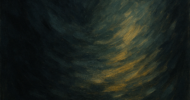
Arguably one of the most famous statues of Western civilization is of the Laocoon group, made between the second century B.C. and the first century A.D, and discovered and excavated in Rome in 1506. Michelangelo himself was supposedly one of the first to view the newly discovered statue, and it is said that it significantly influenced his later work.
The sculpture consists of three figures: a father, Laocoön, and his sons, Antiphantes and Thymbraeus, being attacked by sea serpents. Two serpents are coiled around the three figures. The father, in the center, is attempting to prevent the serpent from biting him. The youngest son, to his right, has been bitten, or is about to be bitten, by the second serpent. To the left of the father, the older son seems less entrapped by the serpents, but is still in the grasp. Both sons are gazing at their father, imploring him for help. The father is staring heavenward, perhaps for help from the gods, for him and for his sons.
According to Virgil, in his Aeneid, Laocoon was a priest of Poseidon who the gods punished because he warned the Trojans of the ruse of the Trojan horse (“I fear the Greeks, even when they bring gifts.”) The wrath of angry gods was vented on an innocent victim and on the sons of an innocent victim.
The statue group has been called the “prototypical icon of human agony in Western art.” That agony, expressed especially by the father, in both his face and his body, is both physical and spiritual agony: physical pain from the serpent’s bite and grasp, the spiritual pain of “Why me?” and the realization that his innocent sons are being punished for what he has done.
For me, this statue group is a graphic depiction of disease-related suffering: The suffering of the patients with the disease, the suffering of those ministering to the patients, and the suffering of the patient’s loved ones.
The sufferer (Laocoon) is in agony, and that agony, for the patient, is, as for Laocoon, both physical and spiritual agony. The physical is the most obvious. Pain is pain, whether from a blocked ureter or a gouty toe, or a malignancy. But the suffering is often spiritual as well. “Why me? I have done nothing to bring this disaster on myself” is the persistent unanswered question for many patients. Or, the spiritual suffering may be from an inappropriate sense of guilt: “What have I done, God, to bring this on me?” (Sophocles’ version of the story is that Laocoon was a priest the gods punished for breaking the vow of celibacy — a Laocoon who may have thought himself justly punished for disobedience.)
But the caregivers of the patient — the doctors and the nurses and all the other ancillary persons — may suffer as well. Sometimes they cannot cure leukemia or fix the infarcted heart, stop the electrifying lancinating pain of trigeminal neuralgia. Consulting their colleagues, they look to whatever heaven they may believe in for help. But despite their Herculean efforts, there may be nothing they can do. Sometimes what they do, despite their best intents, makes things worse. They are not in physical peril, but they suffer nonetheless. Their suffering also comes from the serpents of bureaucracy they find themselves caught up in. Perhaps they cannot give the drugs they wish to give because the patient is uninsured or underinsured. There is more than this one patient who is suffering; other patients are demanding their care. How can they sanely allot their time? If they give all the time, it would really take to the woman who has to be told the chemotherapy trial has failed. They will short-shrift the man waiting to be told about his cardiac catheterization that showed inoperable coronary blockages. Then there is the web of the 20-minute clinic slot. Sometimes that is enough time, but sometimes an hour is not enough. The nurse knocks on the door and looks at her watch. And there is the realization that there are other important commitments. If the nurse stays after hours to sit at the bedside, there are no goodnight stories to be told when he gets home because the children have been put to bed and are already asleep.
Such suffering is uncommon for most health care workers. And this suffering may not be apparent to laypersons; it is not the kind of thing they ask the doctors at the parties. But it occurs more than people think. The suffering may be suppressed, or repressed, by the sufferers themselves; they may not always even be aware of it. They might not be able to handle it if they honestly faced it. But it is still there — and most certainly must be a cause of burnout.
And there is another kind of suffering: the suffering of patients all too aware of the impact of their illness on their loved ones. They remember how they suffered when their parents’ dyings were protracted over weeks or months, and now cannot help but think that their children are going through the same thing. The patients try not to think about the hour-long after-work trips children make to visit them in hospital, the vacation a daughter foregoes to stay with her mother after she is discharged from hospital. And more, the patient knows, despite the good face the child puts on, that they are suffering knowing that the parent has an incurable illness. And patients suffer when they cannot afford the wonder drug they hear about on the evening news. “It takes millions of dollars to get a medication through to the final stages, that’s why it costs so much” is of no comfort to them. “Why does their roommate’s insurance cover it and their’s does not?” they wonder. And then there is the suffering of the “donut hole,” but beyond that, seeing one’s life savings go down the drain. Money that was earmarked for the grandchildren’s college education.
But what touches me most in this statue are the two children gazing at their father. They are caught in the grasp of the powerful entwining serpents, there only because they happen to be the children of a father cursed by the god. These sons, to me, are the loved ones of the people with the illnesses. These children suffer because their parents — or spouses, or children or their dear friends are suffering, and they are helpless to do anything to alleviate that suffering. Their personal lives suffer (although they try to ignore it): Vacations are cancelled, the weekend 18 holes with the foursome they’ve played with for the last ten years is put on indefinite hold. Relationships suffer: A trip to the hospital to visit mother trumps watching the Little League baseball game. Should they consider the promotion that would take them to another state, given dad’s illness? They don’t want to admit these dilemmas, but they are there nonetheless.
The “prototypical icon of human agony in Western art” is powerfully symbolic of the agony of illness and disease, how it affects the sufferer and those who care for the sufferer. The sufferer, the people caring for the sufferer, and the loved ones of the sufferer are caught in a web of despair that seems impossible to escape.
Laocoön
No need to see the face. The agony
he feels the muscles taut beneath the skin
portray. Hand helpless on the serpent’s neck,
unable to prevent the coiling of
the snake around his chest, breath soon to be
snuffed out. Why would Apollo’s awful wrath
be hurled at one who warned the Trojans of
the hollow horse full of weaponed Greeks?
But more, the knowledge that his sons will feel
the serpent’s crunch, not for any deeds they’ve done.
The agony of those with cancer cells
strangling away their lives week after week,
watching their loved ones caught up in the vise
of despair and utter hopelessness.
Joseph Gascho is a semi-retired professor of medicine and humanities. He can be reached at Gascho Word and Image.
Image credit: Wikipedia




























![How doctors can think like CEOs [PODCAST]](https://kevinmd.com/wp-content/uploads/Design-4-190x100.jpg)

